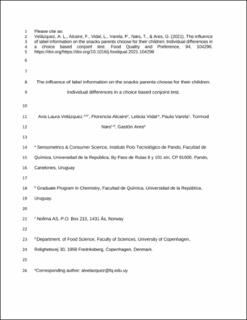| dc.description.abstract | Labels have been reported to influence children's perception and choice of foods. However, the influence of label information on parents’ food choices for their children has not received as much attention in the literature yet. In this context, the objectives of the present study were: i) to evaluate the impact of label information on parents' healthiness perception and choice of two popular snack products, and ii) to explore individual differences in how label design influences parents' healthiness perception and their choice of snack products for their children. A total of 1213 Uruguayan mothers participated in an online survey. A choice-based conjoint test was performed to study the influence of cartoon characters, nutritional claims and nutrient content information on the choice and healthiness perception of chocolate milk and sponge cake labels. Half of the parents were asked to indicate which of the products they would choose as a snack for their children and the other half were asked which of the products was healthier. Data was analyzed by means of a Mixed Logit Model followed by multivariate approaches to explore individual differences (Hierarchical Cluster Analysis and Principal Component Analysis). Results showed that, regardless of the product, nutrient claim had the strongest effect, increasing healthiness perception and encouraging mothers’ choice. For both choice and healthiness perception, two groups of mothers who differed in the relative importance attached to cartoon characters and nutrient content were identified, highlighting the need to investigate individual differences. Results stress the need to regulate the use of nutritional claims, cartoon characters, and other persuasive elements in products of poor nutritional quality targeted at children. | |
